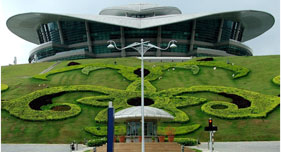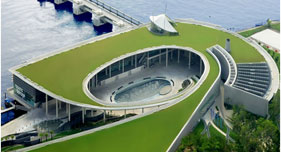Urban Green Landscaping
What is a Green Roof?
A Green Roof refers to a building roof that is designed to be covered with vegetation or other greenery, all planted over a waterproofing membrane in order to prevent seepages and erosion. Some Green Roofs include additional layers that are helpful to the growth of vegetation such as a root barrier, and drainage and irrigation systems, depending on the size of the Green Roof.
There are two types of Green Roofs: Extensive and Intensive. Extensive Green Roofs are six inches or shallower and are frequently designed to satisfy specific engineering and performance goals. Intensive Green Roofs have the capability to become quite deep and merge into large on-structure plaza landscapes with features such as promenades, lawns, large perennial plants, bushes and trees.
Benefits of a Green Roof:
- Reduces temperature
- Mitigates urban heat-island effect
- Reduces temperature of roof surface by up to 31°C
- Reduces ambient temperature by up to 4.2°C
- Improves air quality
- Vegetation filters airborne particles
- Green landscaping can contribute up to 80% reduction in dirt particles
- Improves rainwater retention
- “At source” technique for controlling run-off in urbanised areas
- Reduces surface contaminants, reduced occurrence of soil erosion into waterways
- Reduces CO2 and increase oxygen exchange
- Promotes natural carbon cycling and atmospheric gaseous exchange
- Enhances biodiversity in urbanised areas
- Serves as insulation to reduce heat flux through the roof
- Reduces heating/cooling costs by up to 25%
- Reduces building cooling resources
- Achieves 15% net energy savings in a 5-storey building with roof garden
- Reduces peak cooling load by up to 80%
- Reduces Peak Roof Thermal Transfer Value (RTTV) by up to 80%
Increases the property value by:
- Lessening stress due to thermal expansion and contraction on the membrane, doubling the service life (Velazquez, 1999)
- Improving acoustic insulation
- Reducing noise levels of up to 50 dB (McMarlin, 1997)
- Enabling cultivation of vegetables and fruits
- Enhancing the company’s image and aesthetic appearance of the building
- Fosters community interaction
- Offers therapeutic effects and improved health to users
What is a Green Wall?
A Green Wall is a structure that is either incorporated inside a building or is free-standing, covered in vegetation. VGM Green Walls is comprised of vertical green modules assembled from high strength lightweight structural panels incorporating interlocking snap-on clips. The front panel has a unique grid to facilitate planting of up to sixteen plants per module.
VGM Green Wall modules contain a geotextile liner into which is placed a suitable planting mix. The modules are preplanted in a nursery environment to allow proper establishment to occur before installation on site. VGM modules are either mechanically fastened on walls using steel bolts or inserted into free standing steel support racking structures.
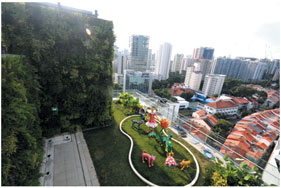
Image courtesy: Elmich Pte Ltd.

Image courtesy: Mr. Patrick Blanc
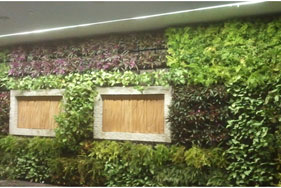
Image courtesy: ZTC International Landscape Solutions Pvt. Ltd.
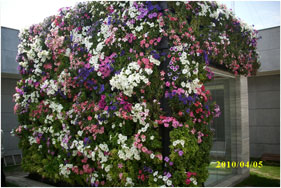
Image courtesy: ZTC International Landscape Solutions Pvt. Ltd.
Benefits of a Green Wall
Benefits of a Green Wall- Improved Heat Insulation
- Reduced energy cost
- Reduced carbon emissions
- Reduced Sound Transmission
- Enhanced Air Quality
- Reduced Airborne Pollutants
- Reduced Stormwater Run-Off
Economic Benefits
- Reduces building cooling load
- Reduces mean radiant temperature of rooms by about 10° C with 74% reduction in energy consumption (Wong, et al., 2009)
- Protects building facade
- Improves acoustic insulation
- Acoustic insertion loss provided by vertical greenery system can reach up to 9.9 dB (Wong, et al., 2009)
- Added Site Value
- Schools and universities with green walls offer educational benefits
- Healthier lifestyles and recreation
- Improved health
What is WSUD?
Water Sensitive Urban Design (WSUD) is a method that incorporates correct Water Cycle Management into urban planning and design. WSUD is based on the premise that the process of urban development and (importantly) redevelopment needs to address adequately the sustainability of the water environment. Stormwater management is a subset of WSUD directed at providing flood control, flow management, water quality improvements and opportunities to harvest stormwater to supplement mains water for non-potable uses (that is, toilet flushing, garden irrigation, etc.).
WSUD recognises that opportunities for urban design, landscape architecture and stormwater management infrastructure are intrinsically linked. The WSUD practices can apply to Greenfield land development sites, redevelopment sites in build-up areas and, in some instances, to retrofits in fully urbanised catchments. The scale of application can range from individual houses, streetscapes and precincts, to whole catchments.
Benefits of a Water Sensitive Urban Design
Environmental Benefits:- Cares for and improves natural water systems in urban developments
- Groundwater recharge
- Protect environmentally sensitive areas from urban development
- Minimizes the impact on the environment of urban development
- Protect the quality of water draining from urban development
- Filtration of stormwater via well vegetated area
- Reduction in capital cost on pipe work and drains
- Reduction in construction cost on grading and tree clearing
- Lower cost of water quality improvement
- Fewer incidences of disruptions of power, transport, and communication
- International as well as national business operations will not be affected
- No damages to properties due to flooding
- Amenable urban and residential landscapes
- No loss of lives due to urban flooding
- Fewer incidences of epidemics during monsoon
- Greater area of public open space within the development
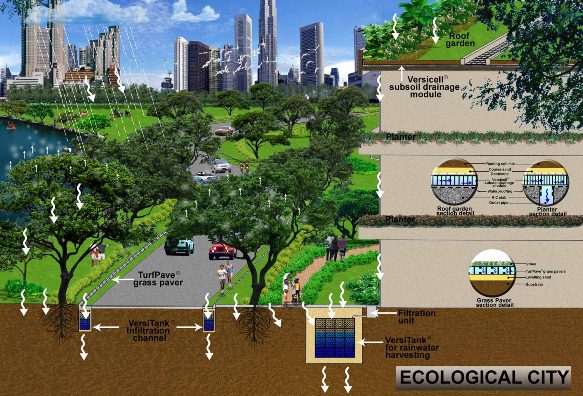
Image courtesy: Elmich Pte Ltd.
What is Rainwater Harvesting?
As the name suggests, Rainwater harvesting is the accumulating and storing of rainwater for reuse, before it reaches the groundwater tables. Rainwater harvesting systems channel rainwater from the roof into storage via a system of gutters and pipes. These systems are easily made from simple local materials. Rainwater may be contaminated due to pollutants like micro organisms, etc. but it can be used to flush toilets, wash clothes, water the garden, wash cars, etc. After treatment the water is considered suitable for drinking also.
Overflow from rainwater harvesting tank systems is used at times to refill aquifers for the purpose of groundwater recharge. There are various types of rainwater harvesting systems from very simple to the complex industrial systems. The first flush of rainwater after dry spell should be allowed to run waste as it will be polluted with dust, etc.
Groundwater recharge, a process where water moves downward form surface water to ground water, occurs anthropologically i.e. artificially when rainwater is harvested and routed to the subsurface. Groundwater recharge is an important process for sustainable groundwater management, since the volume-rate abstracted from an aquifer in the long term should be less than or equal to the volume-rate that is recharged.
Benefits of rainwater harvesting
Environmental Benefits:- Provides an effective stormwater management tool
- Recharge groundwater
- Significant reduction in reliance on water storage dams and ground water
- Reduce the use of drinking water for landscape irrigation
- Reduces off site flooding
- Reduces nutrients and sediment going into rivers and streams
- Increases local stream flows during low-flow periods
- Reduces the contamination of surface water with sediments, fertilizers, and pesticides from rainwater run-off resulting in cleaner lakes, rivers, oceans, and other receivers of stormwater and thereby improves water quality
- Reduces cost for multiple occupancy buildings incurred due to high demand for toilet flushing water, washing vehicles, air conditioner coolant, fire suppression, industrial processes, landscape irrigation and water for housekeeping purposes
- Reduces the use of energy to pump out ground water
- Buildings having large roof areas are conducive for rainwater harvesting and therefore financially viable
- Saves up to 80% of the treated drinking water in a business or commercial building
- Adds life to equipment dependent on water to operate, as rainwater does not produce corrosion or scale like hard water
- Gains eco-home rating for the property
- Solves drainage problems on the property
- The system can be retrofitted to an existing structure or built during new construction
- Flexible in nature allowing for expansion, reconfiguration, and relocation if need be
- Supply of water is assured independently during water restrictions

